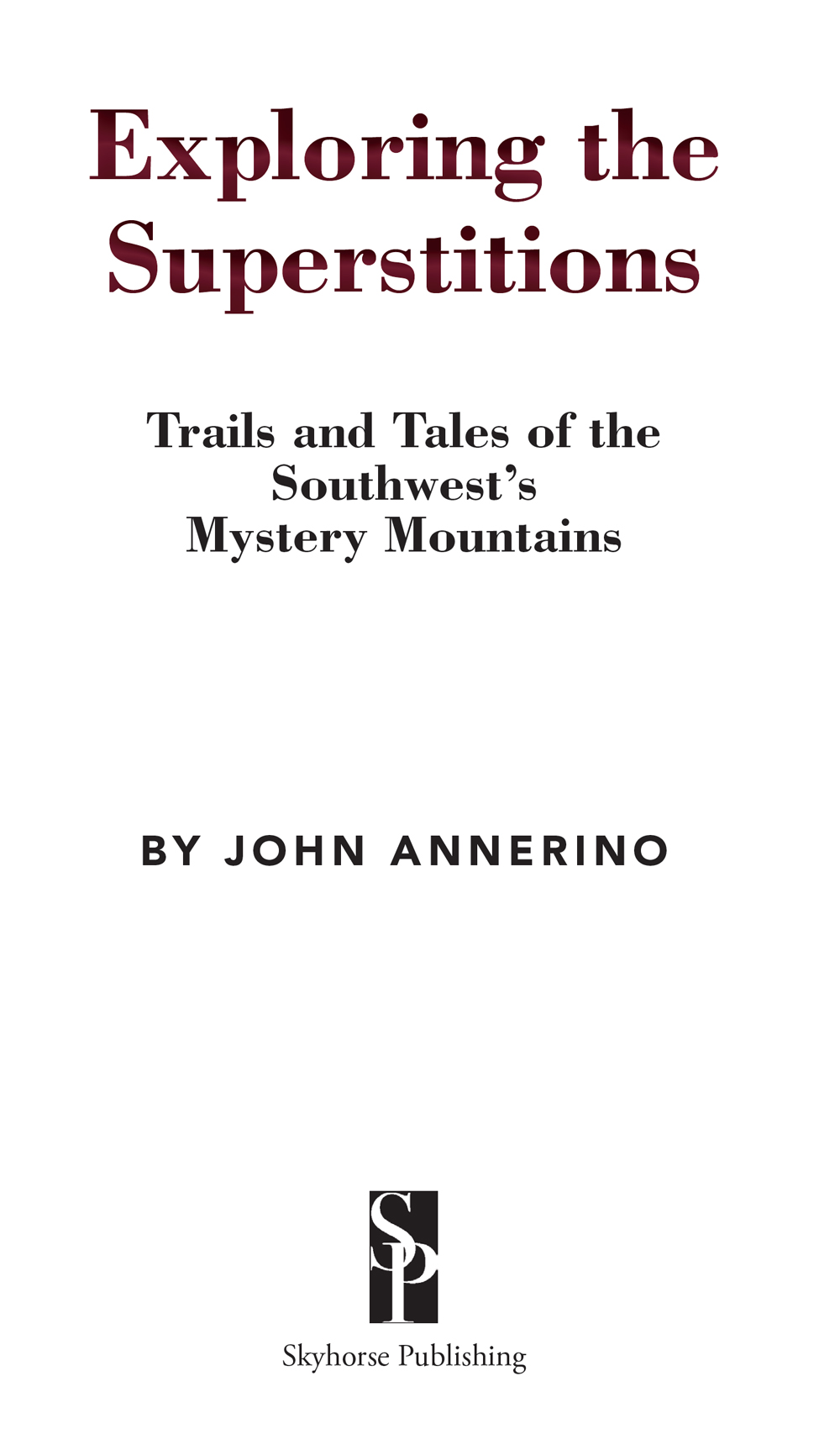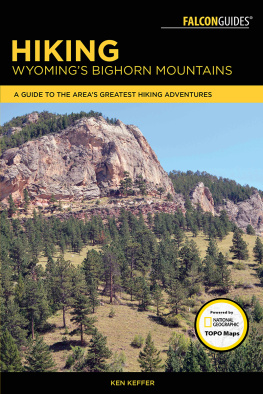


Text, photographs, appendix, and glossary Copyright 2018 by John Annerino
All rights reserved. No part of this book may be reproduced in any manner without the express written consent of the publisher, except in the case of brief excerpts in critical reviews or articles. All inquiries should be addressed to Skyhorse Publishing, 307 West 36th Street, 11th Floor, New York, NY 10018.
Skyhorse Publishing books may be purchased in bulk at special discounts for sales promotion, corporate gifts, fund-raising, or educational purposes. Special editions can also be created to specifications. For details, contact the Special Sales Department, Skyhorse Publishing, 307 West 36th Street, 11th Floor, New York, NY 10018 or .
Skyhorse and Skyhorse Publishing are registered trademarks of Skyhorse Publishing, Inc., a Delaware corporation.
Visit our website at www.skyhorsepublishing.com.
Disclaimer: Hiking, exploring, and prospecting in the Superstition Moutains is dangerous and too often has proven deadly. The author and publisher accept no responsibility for any injury, loss, or inconvenience by any person using this book.
10 9 8 7 6 5 4 3 2 1
Library of Congress Cataloging-in-Publication Data is available on file.
Cover design by Tom Lau.
Cover photo Copyright John Annerino
Historical and Contemporary Photo and Illustration Credits: Edward S. Curtis, Edward H. Davis, Maynard Dixon, Camilius Sidney Fly, William J. Lubken, Andrew Miller, Frank A. Russell, A. Frank Randall, John Annerino / LIFE, and DeGrazia Gallery in the Sun.
Print ISBN: 978-1-5107-2373-3
Ebook ISBN: 978-1-5107-2374-0
Printed in China
Also by John Annerino
Photography & Essay Books
Indian Country: Sacred Ground, Native Peoples
Apache: The Sacred Path to Womanhood
People of Legend: Native Americans of the Southwest
Vanishing Borderlands: The Fragile Landscape of the U.S.-Mexico Border
Colorado Plateau Wild and Beautiful
New Mexico: A Photographic Tribute
Arizona: A Photographic Tribute
Desert Light: A Photographers Journey Through Americas Desert Southwest
Canyon Country: A Photographic Journey
Grand Canyon Wild: A Photographic Journey
The Wild Country of Mexico: La tierra salvaje de Mxico
Canyons of the Southwest: A Tour of the Great Canyon Country from Colorado to Northern Mexico
High Risk Photography: The Adventure Behind the Image
In memory of my father and mother, who nurtured my teens from our home in the long morning shadows of the Superstition Mountains; my white shepherd who accompanied me on my first solo explorations afoot in the Superstitions daunting canyons; for my wife and family who later joined me exploring its spectacular ramparts; the late artist Ettore Ted DeGrazia; and for its Native Peoples who more often than not have been unfairly portrayed with more fiction than fact: Ancient Hohokam ( Huhugam , Those Who are Gone), Pima ( Akimel Oodham , People of the River), Apache ( Nd , The People), Tonto Apache ( Dilzh , People with High Pitched Voices), San Carlos Apache ( Tiis Zhaazhe Bikoh , Small Cottonwood Canyon People), and Southeastern Yavapai ( Enyaeva pai , People of the Sun).
Contents
Acknowledgments
SPECIAL THANKS TO THE APACHE MEDICINE MEN, ( DiYih , One Who Has Power), Robertson Preston, and DiYih Leroy Kenton; Sheena Goseyun and family; Wanda Smith and family; Wendsler Nosie Sr., former San Carlos Apache Tribal Chairman; the San Carlos Apache people who welcomed me and my family to their sacred ceremonial ground; students who trusted me to lead them on one of the first ridgeline traverses of Superstition Mountain, Chris May, and Michael Thomas, who later accompanied me, Lance Laber, Director, and Christine Hubbard, Art Director, DeGrazia Gallery in the Sun, and Native speakers Alejandrina Sierra and Lucinda Bush. Also thank you to proofreader Jeanine Habscom. This book was made possible by my editor Jay Cassell and assistant editor Veronica Alvarado at Skyhorse Publishing.
There is something in a treasure that fastens upon a mans mind. He will pray and blaspheme and still persevere, and will curse the day he ever heard of it, and will let his last hour come upon him unawares, still believing that he missed it only by a foot. He will see it every time he closes his eyes. He will never forget it till he is deadand even then...
Joseph Conrad, Nostromo (1904)
Preface
Nobody gets in and out of the Superstition Mountains completely untouched. Even the most hex proof infidels cannot escape the power of such a magic name, the glamour of the sinister reputation, the occult touch of all those bored and restless haunts, the spirits of the place.
Edward Abbey, The Mountains of Superstition (1972)
FEW MOUNTAINS ON EARTH HAVE PROVEN TO BE more treacherous, hauntingly beautiful, and deceptively enchanting as North Americas Superstition Mountains, located in what author Edward Abbey called, A Dry Corner of the Continent, and what Spanish explorers cursed as a despoblado , uninhabited land, that vast nothingness of the Ninety Mile Desert that once stood between Sonora, Mexicos San Xavier del Bac Mission, and the foot of Arizona Territorys Superstition Mountains. The 29,029-foot Mount Everest ( Sagarmth ) ranks above all other mountains in altitude, supernal beauty, and the number of climbers and Sherpas lives it has claimed (295 people as of this writing). Tibets 21,778-foot Mount Kaila ( Gangs Rin-po-che ) is perhaps the earths most revered and elegant mountain, attracting thousands of Buddhist, Hindu, and other devote pilgrims of other faiths each year on sacred journeys to the holy peak that date back several millennia. The Seven Summits (including Everest) of Argentinas 22,838-foot Aconcagua, Alaskas 20,310-foot Denali, Tanzanias 16,100-foot Mount Kilimanjaro, Russias 18,510-foot Mount Elbrus, New Guineas 16,024-foot Puncak Jaya, and Antarcticas 16,050-foot Mount Vinson, have the distinction of being the highest summits on each of the worlds seven continents, among other attributes. Yet, Arizonas 5,057-foot Superstition Mountains, which some might consider too lowly to be included among the worlds notable mountains, stands apart from all others for the sheer number of lives it has claimed.
As the ancestral ground of the Western Apache who called the mountains Wee-kit-sour-ah , The Rocks Standing Up, and sacred heights to the neighboring Pima, who knew it as Kaktak Tamai , Crooked Top Mountain, no other mountain range in the United States has proven to be as perilous as what sixteenth century Spanish explorers called the Sierra de la Espuma , Mountains of Foam. Once a primeval Sonoran Desert biosphere of towering saguaro cactus forests, desert wildflowers, golden eagles, bighorn sheep, mule deer, Sonoran pronghorn antelope, cactus wrens, jackrabbits, and desert tortoise, the Superstitions innocence was lost, and its sublime natural history was overshadowed, when the advance parties of Spanish conquistador Francisco Vzquez de Coronado ventured north into Nueva Espaa , New Spain, from Mexico City in search of the mythic Seven Cities of Gold in 1540. The march of history and lust for gold changed perceptions of what once was the bountiful hunting-and-gathering domain of indigenous desert dwellers to that of a wild country under siege that was overrun with heavily-armed Euroamericans who knew little about the Sonoran Desert, and less about the traditional lifeways that sustained the Pima, Western Apache, and Southeastern Yavapai and the respect they had for their hallowed land.
Next page













